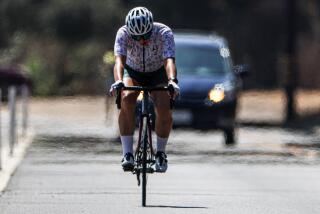Heat Wreaks Havoc on Strawberries : 70% of S.D. County’s Crop May Be Lost, Industry Sources Say
- Share via
San Diego’s record-breaking heat wave this week has played havoc with the county’s $21-million strawberry crop, devastating as much as 70% of the berries that are now ripe, agricultural industry spokesmen said Thursday.
Many growers have been forced to throw out as much as two-thirds of their harvest, and the loss is expected to lead to higher prices and smaller berries soon, according to Jon Ukegawa, sales manager at Giumarra of Carlsbad, a company that markets strawberries for five growers.
“It’s scalding the berries . . . the skin on a strawberry is very delicate. It’s just becoming a ball of mush,” Ukegawa said. Strawberries are more susceptible to the heat than many other types of fruit because they are so fragile.
Possible Further Damage
If the heat continues, the strawberry plants themselves could be damaged, putting the county’s estimated 1,000-acre strawberry industry at risk, said Marilyn Corodemas, the county’s chief deputy agricultural commissioner.
Although Corodemas could not be more specific about the long-term effect of the heat wave on the plants, she said the situation is serious.
Ukegawa said the heat could also affect the size of those berries not ready for picking. “Sometimes hot weather will bring on the berries so quickly they don’t have a chance to get big. . . . We pick them when they’re ripe, and, with the hot weather, they ripen earlier.”
Corodemas, who inspected several strawberry fields Wednesday, said the temperature on the inside of the berries themselves was as high as 110 degrees.
‘Slowly Liquefying’
“They’re just slowly liquefying in the heat. It looks like strawberry preserves more than anything else,” she said.
“What’s happening is that the growers are attempting to pick as much as they can. What they’re doing is picking ones that have not been heat damaged. They’re trying to harvest the ripe or near-ripe ones that haven’t been affected. Then they’re going to have go back and pull the damaged ones,” Corodemas said.
Ukegawa and Wes Yamamoto, sales manager at Vista Sales, said most of the berries now being sold were those harvested from shady areas.
“They’re not being picked any earlier. You can only pick them when they get full color anyway, you can’t pick them when they’re green. If the sun’s beating down on them, it’s a loss,” Yamamoto said. “But you are seeing less production up and down the state.”
Disease Threat
Yamamoto said bad fruit still needs to be picked so as to avoid disease. As a result, growers continue to face picking costs while having to throw out much of the fruit.
To make matters worse, the cold in January gave the strawberry season a late start. “Part of the problem with the strawberry crop this year is that it’s kind of late to begin with. It’s been cool and they haven’t developed as quickly as we would have liked,” said Dick Jones, chief financial officer for Agri Sales in Vista.
A woman working at a small strawberry stand in Bonsall said the fruit is literally “cooking on the vine.”
“There’s nothing you can do,” Ukegawa said. “The market’s pretty good, and here they are throwing two-thirds away. It isn’t a real happy situation for the growers.”
More to Read
Sign up for Essential California
The most important California stories and recommendations in your inbox every morning.
You may occasionally receive promotional content from the Los Angeles Times.













![Vista, California-Apri 2, 2025-Hours after undergoing dental surgery a 9-year-old girl was found unresponsive in her home, officials are investigating what caused her death. On March 18, Silvanna Moreno was placed under anesthesia for a dental surgery at Dreamtime Dentistry, a dental facility that "strive[s] to be the premier office for sedation dentistry in Vitsa, CA. (Google Maps)](https://ca-times.brightspotcdn.com/dims4/default/07a58b2/2147483647/strip/true/crop/2016x1344+29+0/resize/840x560!/quality/75/?url=https%3A%2F%2Fcalifornia-times-brightspot.s3.amazonaws.com%2F78%2Ffd%2F9bbf9b62489fa209f9c67df2e472%2Fla-me-dreamtime-dentist-01.jpg)